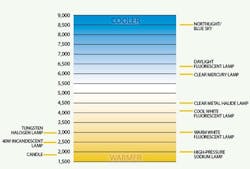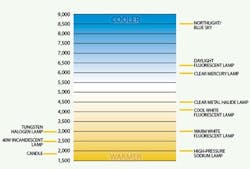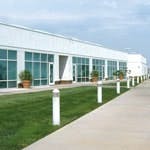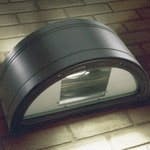Armed assailant or fallen tree limb: If exterior lighting is scarce, both are dangerous during nighttime hours. Poorly lit spaces after dark invite crime and increase the likelihood of accidents.
The right lamps, appropriate fixtures, proper maintenance, and lighting design that follows the Illuminating Engineering Society of North America’s (IESNA’s) Guideline for Security Lighting for People, Property, and Public Spaces (G-1-03) result in a feeling of safety for building occupants/tenants, students, employees, and shoppers. Additionally, vagrants are less likely to consider criminal activity in a place where it’s easy to be seen.
Lamps
Metal Halide
Witnesses of criminal acts rely heavily on color to describe a perpetrator’s hair, his/her clothing, and the getaway vehicle. A color rendering index (CRI) of between 1 and 100 indicates how accurately colors are rendered by a light source. The greater the number, the better the light source is at rendering colors. In order to achieve accurate and confident color identification, IESNA recommends a CRI of 50 or higher. Some metal halide lamps provide excellent color rendering; however, in applications where metal halide lamps are left on 24 hours a day (e.g. in a parking ramp), it’s important to turn the lamps off regularly (every 100 hours or once per week). “If metal halide lamps are left on, they don’t have the opportunity to fail in the off position and can explode,” says Mark Lien, manager-SOURCE, Cooper Lighting Center, Peachtree City, GA.
High-Pressure Sodium (HPS)
HPS lamps are more popular because they have a significantly longer life and are slightly more efficient than metal halide. They are also less expensive. “A lot of institutional campuses use high-pressure sodium lighting. It has a lower color temperature, so it’s almost orange-looking and a little bit warmer and more inviting than metal halide,” explains Don McLaughlin, vice president of sales, Sternberg Lighting, Roselle, IL. The disadvantage of HPS is its poor color rendering. “If you see a person, it’s very difficult to tell the color of [his/her] clothing and (whether [he/she] had a green shirt or a black shirt on),” explains McLaughlin.
Fluorescent
Use of fluorescent lamps is on the rise. Their instant-start capability makes them especially desirable in certain applications. As of Oct. 1, 2005, California’s updated Building Energy-Efficiency Standards mandated that exterior lighting be reduced to 50 percent of power at close of business or curfew. “You can’t turn metal halide to 50 percent of power easily or without significant expense. But, you could put two ballasts and two fluorescent lamps in a fixture and turn off just one to achieve the 50-percent reduction,” explains Lien.
The Correlated Color Temperature Scale
The color appearance of various light sources can be defined in terms of color temperature, measured in “degrees” Kelvin (K).
Fixtures/Components
Types of Fixtures
Pole-mounted luminaires are the most common type of exterior lighting fixture. According to IESNA, “Large sites with a need to provide protection for persons and property are lighted most economically with high-wattage, high-mounted luminaires [that are] spaced to provide uniform illuminance.” The G-1-03 guideline also recommends mounting heights of 30 to 60 feet in these areas, with shorter, pole-mounted fixtures mounted between 10 to 20 feet in pedestrian zones. Fewer poles are needed with taller fixtures. However, many localities have height restrictions. “When lower mounting heights are used, more poles and lower luminaire wattages will likely be required to maintain adequate uniformity and avoid over-lighting,” explains the IESNA guideline.
| There are generally four types of exterior lighting fixtures: 1. pole-mounted, 2. bollards, 3. surface-mounted, and 4. floodlighting. To provide optimum lighting design, make sure light levels are uniform, fixtures are properly spaced to reduce shadows, glare is controlled, and maintenance is performed regularly. |
Surface-mounted luminaires (including wall packs) are often installed on building façades or parking garage ceilings. IESNA cautions users about the selection and placement of these fixtures. “Care should be taken to use wall-mounted and ceiling-mounted luminaires that distribute light onto surfaces without glare to motorists or pedestrians,” the Lighting for Exterior Environments (RP-33-99) IESNA guideline states.
Additional exterior lighting fixtures include bollards and floodlights. Bollards provide excellent pathway lighting and are shaped like short, thick posts. Floodlight luminaires are typically used for building-façade lighting and must be controlled with glare shielding to avoid light trespass and pollution.
Desirable Features
“A good fixture will be designed for easy maintenance,” Lien explains. Some pole-mounted fixtures provide tool-less entry, which makes relamping as easy as unhooking some snaps to open a hinged door. “If someone is up in a bucket truck, [he/she doesn’t] want to be juggling screwdrivers. If that individual drops a screw 30 feet, you can imagine the time loss,” explains Lien. Also, quick access to the ballast is a nice feature. “Ballasts can be designed on what’s called a ‘power door,’ ” he explains. “Just take the door right off - it disconnects quickly. Put a new door on with the new ballast, close it, and you’re done.”
Durability of Materials
When purchasing outdoor lighting fixtures, their ability to withstand abuse from both Mother Nature and vandals is extremely important. Lens material greatly impacts fixture durability. There are three options: glass, acrylic, and polycarbonate. Glass is the most brittle and breaks easily, while some polycarbonate lenses are strong enough to hold up to BB-gun fire. Acrylic is less breakable than glass, but not as durable as polycarbonate.
The disadvantage of acrylic, and especially polycarbonate, is the rate at which the lenses yellow. A yellowed lens reduces the amount of light emitted from the fixture, compromising security and safety. “Polycarbonate tends to yellow a little bit faster. As far as yellowing, it probably only lasts half as long as an acrylic lens,” McLaughlin explains. “At first, you might have been getting 2 footcandles on the ground. After 3 years, you’re down to 1 footcandle; the light output has been cut in half,” he says. As a result, you’ll need to replace polycarbonate lenses more frequently.
Another way to determine a fixture’s durability is its ingress protection (IP) rating. “Most lighting manufacturers publish the IP rating of their fixtures, which is a rating of how weather resistant a particular fixture is,” explains Robert Shook, lighting designer, Schuler Shook Lighting Designers, Chicago. The IP rating is a 2-digit number: The first number is a measurement from 0 to 6 that indicates how well the fixture is sealed against dust and heat, and the second number is a measurement from 0 to 8 that indicates how moisture- or water-proof the fixture is (8 being fully submersible). A well-sealed fixture with an IP rating of 66 will prevent dirt from accumulating on the lens (which reduces efficiency) and moisture from deteriorating electrical components.
Design Considerations
Quality
All areas on the property should be lit at approximately the same level. Light that is not uniform creates shadows that can render steps, curbs, or even fallen branches from a nearby tree serious safety hazards. According to Lien, “If you have bright pools of light outside and dark areas in between, your eye may not adapt quickly to identify what’s happening in the dark areas.” To prevent such a scenario, space fixtures to avoid shadows and minimize the impact of single-lamp failure.
Lighting an outdoor environment with little or no glare is equally important. Often referred to as veiling luminance, glare can cause discomfort and impair vision. Proper placement and positioning of fixtures can dramatically reduce glare. Additionally, many fixtures can be outfitted with glare-control accessories (such as shields or louvers).
Emergency Evacuations
A number of states have adopted the Intl. Building Code, which mandates the need for emergency lighting outside of buildings. “All businesses, unless they are on a public street, have to provide a safe dispersal area (for the people in the building) that is at least 50 feet out from the building,” says Lien. “The owners of that building have to provide a safe and unobstructed path to the dispersal area. If there is a power outage and it’s nighttime, the only way it would be safe is if it were lit.” Fluorescent lamps are ideal for these applications because of their instant-start capabilities and their ability to operate on battery packs.
Surveillance System Compatibility
Poor lighting design or improperly placed lighting that obstructs a surveillance camera’s view can compromise security dramatically. When shopping for cameras, ask about spectral response. The spectral output of light sources should be matched to the camera’s spectral response.
Light Trespass and Pollution
Light trespass is defined as “light that spills over into an adjacent property or nuisance glare resulting from excessive brightness.” It’s important that your exterior lighting solution doesn’t become a lighting problem. IESNA, in its RP-33-99 guideline, suggests selecting luminaires with tightly controlled candela distributions, using sharp-cutoff reflectors and refractors, and keeping floodlight angles low.
Light pollution occurs when stray light is emitted into the atmosphere and reflects off of dust, water vapor, and particles in the air. Lighting design that incorporates fixtures and accessories which control upward lighting emissions can greatly reduce light pollution.
Operations and Maintenance
Lighting Controls
Energy management systems are effective in controlling exterior lighting; they can be programmed to turn lights on and off, as well as lower lighting levels, if desired. “We generally recommend that all exterior lighting be switched on and off by a control system that combines a photocell and time clock. Exterior lighting should be switched on about 30 minutes before sunset. Lighting for safety and security is usually kept on throughout the evening. Lighting associated with [the] building façade is generally switched off at 11 p.m. or 12 a.m.,” explains Shook.
Relamping Strategies
Replacing one lamp at a time can be time-consuming for crews. To minimize frequent relamping, consider group relamping. “We generally recommend that maintenance be performed on a group relamp basis rather than an ‘as-needed’ basis. We advise our clients [about] the expected life of each lamp so that the maintenance team can schedule regular maintenance near the end of the lamp life as opposed to each individual burnout,” explains Shook.
If you decide against group relamping, invite security officers, students, and tenants to report lamp outages and vandalism. Daily or weekly surveys of the lighting are necessary.
As common practice, have maintenance crews wipe out the inside of light fixtures during relamping. “Lumen depreciation results from dirt laying on the lens, lamp, reflector, or all three. Secondly, when dust or moisture start to accumulate in the fixture, it can also affect the distribution of light,” explains Lien.
Landscaping
Don’t compromise your lighting design by allowing tree branches and bushes to block the view of lamps. Twice annually, conduct an audit of all exterior lighting. An ideal time is when landscaping is at its peak; pruning can be done to get rid of any obstructions.
Jana J. Madsen ([email protected]) is managing editor at Buildings magazine.





